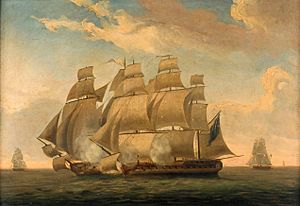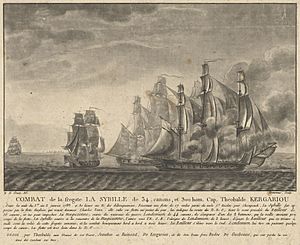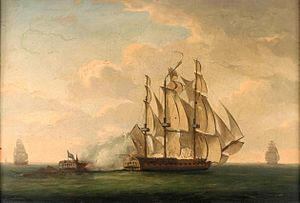Action of 2 January 1783 facts for kids
Quick facts for kids Action of 2 January 1783 |
|||||||
|---|---|---|---|---|---|---|---|
| Part of the American Revolutionary War | |||||||
 Action between HMS Magicienne and Sibylle, 2 January 1783 by Robert Dodd |
|||||||
|
|||||||
| Belligerents | |||||||
| Commanders and leaders | |||||||
| Strength | |||||||
| 1 Frigate | 1 Frigate 1 Sloop of War |
||||||
| Casualties and losses | |||||||
| 16 killed & 31 wounded | 14 killed & 42 wounded | ||||||
The action of 2 January 1783 was a small but intense naval battle. It happened in the Caribbean Sea during the final part of the American War of Independence. Two warships, the British frigate HMS Magicienne and the French frigate Sibylle, fought for almost two hours. Both ships were badly damaged by the end of the fight.
Contents
A Fierce Sea Battle in 1783
Getting Ready for Battle
Captain Thomas Graves was in charge of HMS Magicienne. His ship was part of the British fleet blocking the port of Cap-François in Saint-Domingue. This was part of the Royal Navy's operations from its Jamaica base.
One day, HMS Endymion spotted a group of French ships, called a convoy, heading out to sea. This convoy had left Cap-François on December 27, 1782. It was carrying valuable goods and money to Chesapeake Bay.
A ship from the French convoy got separated and sailed towards the British. At 6:30 AM, Endymion signaled that the ships were French. By 9:00 AM, Endymion caught the stray ship, which was named Celerity. It was a valuable capture. Meanwhile, Magicienne arrived to help move the captured people and cargo.
The French commander, Kergariou-Locmaria, decided to sail his warship towards the British. He hoped to draw them away from his convoy. He signaled his convoy to keep going on its planned route.
The Fight Begins
Captain Graves quickly prepared HMS Magicienne for battle. Soon after, three French ships from the convoy turned away and followed the main group. The French warships then raised their flags and got ready to fight.
At 12:30 PM, Magicienne got close to the smaller French ship, the sloop Railleur, which had 14 cannons. A short fight began. After firing two full sets of cannons from one side (called broadsides) into the sloop, the French frigate Sibylle came back to help Railleur. Magicienne then moved away.
The Sibylle was a fast frigate with many powerful cannons. It had a crew of 271 men and was commanded by the Comte de Kergariou-Locmaria. Magicienne sailed on and soon got very close to Sibylle. The cannons were almost touching as the sailors fired. They even threw things at each other through the gun openings to distract their enemies.
The End of the Battle
By 2:15 PM, Magicienne had almost stopped Sibylle from firing. The British sailors hoped the French would soon give up. But then, a French cannonball hit Magicienne, bringing down its mizzen and fore-topmast (two of its masts). The broken parts fell away from Sibylle, and the French ship fell behind.
Right after Magiciennes masts fell, a broadside from the British ship hit Sibylles front deck. This killed eleven men. Kergariou, the French commander, was hit on the back deck. His men thought he was dead, but he was only wounded. Lieutenant Charles Gabriel Morel d'Escures, the second in command, continued the fight.
Around 2:20 PM, Magiciennes front and main masts also fell overboard. Sibylle then sailed away as the British ships Endymion and Emerald were seen approaching. Magicienne could not move well, so it just fired every gun it could at Sibylles back. The battle had lasted for one hour and forty-five minutes.
What Happened Next
HMS Magicienne was pulled by Endymion and Emerald to Jamaica two weeks later. The only captured ship, Celerity, never reached port. It crashed on a rock near the island of Heneaga on January 9.
The French ship Sibylle was very damaged. It was later captured on January 22, 1783, by HMS Hussar under Thomas McNamara Russell. Captain Thomas Graves later created two pictures of the battle, showing its beginning and its end.
See Also
- American Revolutionary War
- Frigate
- Sloop of War
Images for kids






